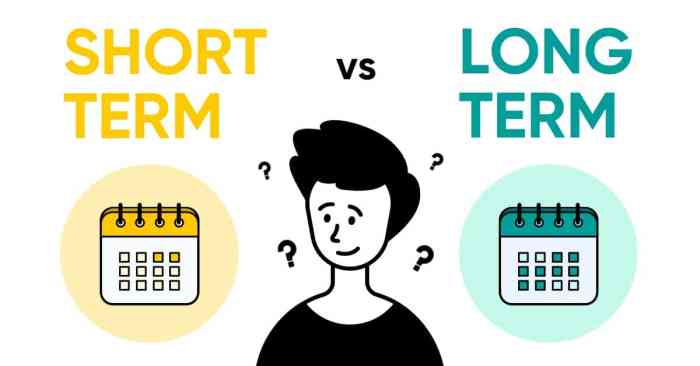Long-term vs short-term real estate investments sets the stage for this enthralling narrative, offering readers a glimpse into a story that is rich in detail and brimming with originality from the outset.
As we delve deeper into the realm of real estate investments, exploring the contrasting strategies of long-term and short-term approaches unveils a world of opportunities and risks awaiting savvy investors.
Long-term Real Estate Investments: Long-term Vs Short-term Real Estate Investments

Investing in real estate for the long term involves acquiring properties with the intention of holding onto them for an extended period, typically five years or more. This strategy allows investors to benefit from appreciation, rental income, and tax advantages over time.
Examples of Long-term Real Estate Investment Strategies
- Buy and Hold: Purchasing properties with the intention of renting them out for consistent cash flow and long-term appreciation.
- Real Estate Investment Trusts (REITs): Investing in publicly traded companies that own, operate, or finance income-producing real estate across various sectors.
- Real Estate Syndication: Pooling funds with other investors to acquire larger properties or portfolios for long-term growth and profits.
Benefits of Choosing Long-term Real Estate Investments
- Stable Income: Rental properties can provide a consistent stream of passive income over the long term.
- Appreciation: Real estate values tend to increase over time, allowing investors to build equity and wealth.
- Tax Advantages: Long-term investors can benefit from tax deductions, depreciation, and capital gains tax advantages.
Key Factors to Consider for Long-term Real Estate Investments
- Location: Choose properties in prime locations with potential for growth and demand.
- Market Trends: Analyze market conditions, trends, and forecasts to make informed investment decisions.
- Property Management: Ensure proper maintenance, tenant screening, and efficient management to maximize returns.
- Exit Strategy: Plan for the long term by considering potential exit strategies such as selling, refinancing, or passing down properties to heirs.
Short-term Real Estate Investments

Short-term real estate investments refer to properties purchased with the intention of holding them for a relatively brief period, typically less than five years. These investments are focused on generating quick returns through strategies such as fix-and-flip, short-term rentals, or wholesaling.
Examples of Short-term Real Estate Investment Opportunities
- Fix-and-Flip Properties: Investors purchase properties below market value, renovate them, and sell for a profit within a short timeframe.
- Short-Term Rentals: Properties rented out on platforms like Airbnb for a few days or weeks at a time, providing a higher rental income compared to traditional long-term rentals.
- Wholesaling: Investors secure properties at a discounted price and assign the contract to another buyer for a fee, without actually purchasing the property themselves.
Advantages and Disadvantages of Short-term Real Estate Investments
- Advantages:
- Quick returns: Short-term investments offer the potential for fast profits compared to long-term holdings.
- Flexibility: Investors can adapt to changing market conditions and adjust strategies accordingly.
- Disadvantages:
- Higher risk: Short-term investments are more susceptible to market fluctuations and economic downturns.
- Time and effort: Requires active involvement in property management, renovations, and deal sourcing.
Risks Associated with Short-term Real Estate Investment Strategies
- Market Volatility: Short-term investments are more sensitive to market changes, making them riskier compared to long-term strategies.
- Liquidity Risks: In a downturn, it may be challenging to quickly sell a property for a profit, leading to potential losses.
- Overleveraging: Borrowing too much money to fund short-term investments can result in financial strain if the property fails to generate expected returns.
Factors Influencing Investment Decisions
When deciding between long-term and short-term real estate investments, there are several key factors that investors must consider to make an informed decision.
Market Conditions
Market conditions play a crucial role in determining whether to opt for long-term or short-term real estate investments. In a seller’s market where demand outweighs supply, short-term investments may yield quick profits due to rising property values. On the other hand, in a buyer’s market with an oversupply of properties, long-term investments could be more favorable as prices may appreciate over time.
Economic Factors
Economic factors such as interest rates, inflation, and economic growth can significantly impact the profitability of both long-term and short-term real estate investments. For instance, low-interest rates can make short-term financing more attractive for investors looking to flip properties quickly, while high inflation rates may erode the returns of long-term investments over time.
Role of Location
The location of a property plays a vital role in determining the success of both long-term and short-term real estate investments. A prime location with access to amenities, good schools, and transportation hubs can increase the demand for rental properties in the long run, making it a lucrative option for long-term investments. Conversely, properties in less desirable locations may be better suited for short-term investments to capitalize on any potential appreciation.
Investor Goals and Risk Tolerance
Investor goals and risk tolerance also play a significant role in deciding between long-term and short-term real estate investments. Investors seeking steady cash flow and long-term appreciation may prefer the stability of long-term investments, while those looking for quick returns and willing to take on more risk may opt for short-term investments such as fix-and-flip projects.
Strategies for Maximizing Returns

When it comes to maximizing returns on real estate investments, there are several key strategies that investors can employ to ensure optimal profitability. From comparing potential returns on long-term versus short-term investments to leveraging financing options, here are some essential tips for maximizing returns in real estate.
Comparing Potential Returns, Long-term vs short-term real estate investments
One effective strategy for maximizing returns on real estate investments is to compare the potential returns of long-term versus short-term investments. While short-term investments may offer quick profits, long-term investments often provide more stable and consistent returns over time. To illustrate this comparison, consider the following table:
| Investment Type | Potential Returns |
|---|---|
| Long-term | Stable, consistent returns with potential appreciation |
| Short-term | Quick profits but higher volatility and risk |
Diversification Strategies for Real Estate Investment Portfolio
Another crucial strategy for maximizing returns is diversifying your real estate investment portfolio. By including both long-term and short-term investments, you can spread out risk and potentially increase overall profitability. It is recommended to have a mix of properties with varying holding periods and income potential to create a well-balanced portfolio.
Leveraging Financing Options
To optimize returns on long-term real estate investments, investors can leverage financing options such as mortgages or loans. By using leverage, investors can amplify their returns by investing a smaller amount of their own capital and potentially increasing their overall profitability. However, it is essential to carefully consider the risks associated with leveraging and ensure that the investment is viable in the long run.
Tax Implications and Benefits
When it comes to tax implications and benefits, there are differences between long-term and short-term real estate investments. Long-term investments may qualify for lower capital gains tax rates if held for a certain period, while short-term investments are typically subject to higher ordinary income tax rates. Investors should consult with a tax professional to understand the specific tax implications of their real estate investments and maximize tax benefits.
In conclusion, the choice between long-term and short-term real estate investments is a pivotal decision that can shape your financial future. By weighing the benefits, risks, and factors influencing investment decisions, you can craft a diversified portfolio that maximizes returns and minimizes potential pitfalls.
When it comes to buying a rental property as an investment , there are several factors to consider such as location, rental demand, and potential return on investment. Conducting thorough research and due diligence is crucial before making a purchase decision.
Investing in Airbnb investment properties can be a lucrative opportunity for generating passive income. However, it is important to understand the regulations in your area, manage guests effectively, and maintain the property to attract more bookings.
Identifying the best cities for rental property investment is essential for maximizing your ROI. Factors such as job growth, population trends, and rental market stability can help you determine which cities offer the most potential for long-term success.




